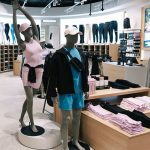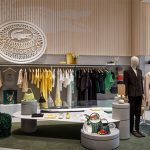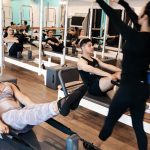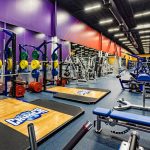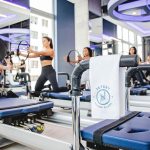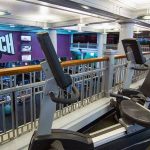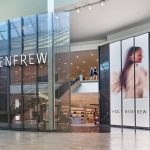Fighting off significant currency-exchange headwinds, Nike Inc. reported earnings rose 22.6 percent in the first quarter ended August 31, to $1.8 billion, or $1.34 a share. Results easily eclipsed Wall Street's consensus estimate of $1.19.
The gains reflected broad-based revenue growth, gross margin expansion, selling and administrative expense leverage, and a lower effective tax rate.
Net revenues rose 14 percent on a currency-neutral basis with reported revenues ahead 5.4 percent to $8.41 billion.
On a conference call with analysts, Mark Parker, president and CEO, said the company continues to benefit from its “deep relationships” with athletes and consumers, commitment to innovation and diversified portfolio.
“While we are not immune to the macroeconomic challenges that all businesses are facing, we are best positioned and best resourced to navigate the short-term and thrive for the long-term,” said Parker.
For the Nike Brand, revenues rose 15 percent on a currency-neutral basis in the quarter, with double-digit growth across nearly every geography, and most key categories. Nike Brand direct-to-consumer (DTC) revenue increased 21 percent, driven by new store expansion, continued strong growth in online sales, up 46 percent, and comp store growth of 7 percent
More impressively, on a currency-neutral basis, Nike Brand futures orders grew 17 percent, driven by an 11 percent increase in units and a 6 percent increase in average selling prices. All geographies grew double digits, except emerging markets, which grew 6 percent. On a reported basis, futures grew 9 percent, reflecting a stronger U.S. dollar against nearly all international currencies.
“Clearly, the category offense continues to drive growth around the world, and it remains the foundation of our strategy as we look ahead,” said Trevor Edwards, president of Nike Brand, on the call.
On a reported basis, Nike Brand sales advanced 6.4 percent, to $7.9 billion. By product segment, footwear led the gains, climbing 18 percent on a currency-neutral basis to $5.12 billion (up 9.0 percent reported.) Apparel grew 12 percent on a currency-neutral basis to $2.34 billion (4.7 percent reported). Equipment, which includes Nike Golf, was the one weak category, sliding 3 percent on a currency-neutral basis to $408 million (down 10.3 percent reported.) Total Nike Brand’s EBIT rose 25.6 percent to $1.63 billion. Futures for Nike Brand on a reported basis were ahead 9 percent.
North American Sales Climb 9 Percent
In North America region, sales for Nike Brand rose 9 percent on a currency-neutral basis. The increases were driven by strength in nearly every key category, led by sportswear, basketball, men's training and running.
By product segment on a currency-neutral basis, footwear climbed 9 percent to $2.37 billion, apparel jumped 13 percent to $1.25 million, and equipment slumped 17 percent to $186 million.
On a reported basis, North America revenue grew 8.4 percent, to $3.8 billion. EBIT rose 7.2 percent, to $1.04 billion due to slightly lower gross margin, partially offset by SG&A leverage. Futures were up 15 percent on a currency-neutral basis and 14 percent on a reported basis.
“The energy of our brand in North America is clear,” said Edwards. “With continued strong demand across our executions with wholesale partners such as Dick's Sporting Goods, Foot Locker, and The Finish Line, we continue to serve this consumer through our amplified strategy, delivering both performance and lifestyle products.”
He noted that the region at the same time continued to work to effectively manage the flow of inventory, including the impacts of the West Coast port congestion from earlier in the year. Added Edwards, “While the flow of product from the port has now returned to normal, we are working to efficiently clear excess inventory to keep our in-line channel healthy.”
In addition, Nike recently expanded its North American distribution center and is working to bring the new capacity fully online.
“We expect both these efforts to be complete by the end of Q3, and inventory levels in North America to normalize at that time,” said Edwards. “Ultimately, our confidence in the category offense in North America gives us the roadmap to continue to unlock growth opportunities both this year, and far into the future.”
Western Europe boosted by sportswear, basketball and running
Among other regions, sales in Western Europe for Nike Brand grew 14 percent on a currency-neutral basis. Nearly all key categories delivered strong growth on a currency-neutral basis, fueled by sportswear, basketball and running, while global football declined due to tough comparisons to higher World Cup revenues in the prior-year.
On a reported basis, Q1 revenue in Western Europe declined 4.2 percent to $1.64 billion, due to weakness in the euro; however, EBIT increased 20.0 percent to $485 million, driven by gross margin expansion and SG&A leverage. Futures grew 22 percent on a currency-neutral basis and 6 percent on a reported basis.
“This growth continues to be fueled by the transformation of the marketplace along the category offense,” said Edwards. “This work includes elevated executions at Intersport, the new Oxford Street's location with JD Sports in London, and the expansion of the House of Hoops at Foot Locker in Berlin.”
Nike’s own DTC “continues to perform very well” in Western Europe, delivering 31 percent growth in Q1. Edwards added, “By being both deliberate and aggressive, we lead the market as Western Europe's most desired sports brand. We're excited about what the future holds, as we execute our complete offense in Western Europe.”
China Boasts 30 Percent Growth
In Greater China, sales for Nike Brand leapt 30 percent on a currency-neutral basis to $886 million, and also rose 30 percent on a reported basis, to $886 million. The gains were driven by strong performance across nearly all key categories, including sportswear, running and basketball. Said Andy Campion, Nike’s CFO, “While we are very mindful of the macroeconomic volatility in China, our brand has never been stronger and our marketplace has never been more healthy. We have momentum across nearly all key categories, as well as continued strength in our DTC business.”
EBIT in China vaulted 51.4 percent to $330 million due to strong revenue growth, gross margin expansion, and SG&A leverage. Future orders rose 27 percent on a currency-neutral basis and 22 percent on a reported basis.
Edwards said China’s sales gains were aided by a successful re-profiling of its key wholesale partner doors while the DTC business was boosted by comp increases and an acceleration of its e-commerce business.
China also benefited from activation efforts, including its athletes excelling at the Track and Field World Championships in Beijing and Lebron James, Kobe Bryant, Anthony Davis and Paul George all participating in Nike basketball events. Last week, Nike announced that Michael Jordan will travel to Shanghai in mid-October to celebrate the 30th anniversary of the Air Jordan franchise. Said Edwards, “The incredible growth we saw in China this quarter reflects our ongoing efforts to align the marketplace to the category offense, a strategy that we expect will drive growth in this critical geography for many years to come.”
Emerging Markets Boosted by Mexico Turnaround
In the Emerging Markets region, sales for Nike Brand ran ahead 19 percent on a currency-neutral basis. Nearly all territories delivered strong growth in the quarter. Nearly every key category also grew for the quarter, led by sportswear, action sports and basketball.
Mexico returned to strong growth as a result of efforts to optimize inventory and elevate the brand’s distribution. Edwards highlighted the launch of House of Her in Mexico City, a store that also includes a community element; marketplace executions with Liverpool, which is Mexico's largest department store; and strength at Innovasport.
“As these new doors prove by elevating the marketplace, we grow the market in key geographies and territories,” said Edwards. “Overall, we believe we are now well-positioned to drive profitable long-term growth in Mexico.”
In Brazil, revenue was flat and the brand gained share although the overall performance was “still reflective of the continued challenges in the macroeconomic landscape,” said Edwards. He said Nike will continue to focus on improving differentiation in Brazil. Said Edwards, “Overall, we continue to see tremendous growth potential for the emerging markets long-term, and are confident that we are executing the right strategies to realize that potential in this important geography.”
On a reported basis, emerging-markets revenue increased 3.4 percent for the quarter to $966 million. EBIT vaulted 65.4 percent, to $258 million, reflecting gross margin expansion and SG&A leverage. Future orders were up 6 percent on a currency-neutral basis but down 11 percent on a reported basis.
In Central & Eastern Europe, sales for Nike Brand jumped 26 percent on a currency-neutral basis. The gains were driven by double-digit currency-neutral growth in every territory except Greece. Double-digit growth was seen in nearly every key category. On a reported basis, Q1 revenue grew 2.0 percent to $401 million, reflecting significantly weaker currencies, in particular the ruble and the Turkish lira. EBIT jumped 42.0 percent to $98 million, due primarily to strong gross margin expansion and SG&A leverage. Futures rose 16 percent on a currency-neutral basis but slid 3 percent on a reported basis.
In the Japan region, sales for Nike Brand rose 35 percent on a currency-neutral basis and grew 11.9 percent on a reported basis, to $179 million. Operating earnings in Japan nearly tripled to $36 million from $11 million. Futures rose 12 percent on a currency-neutral basis and 26 percent on a reported basis.
Run, Performance Apparel and Women’s Highlight for Nike Brand
Highlighting a few categories driving the gains, Edwards said running was boosted by a strong response to its Zoom Air technology that supported gains for the Pegasus 32, Vomero 10 and Elite 8.
The performance apparel business continued to build on the growth momentum of Nike Dri-FIT technology, marked by a strong launch of the Contour running top with zoned breathability. The Air Max 95 was also successfully relaunched along with the Air Max 95 Ultra with updated technologies.
The women’s business grew double-digits, led by the launch of the MetCon 1 training shoe and ongoing strength in styles such as Dri-Fit knit bras, and Nike Pro tights. Women’s sportswear also delivered strong growth, with footwear styles like the Roshe and the entire Air Max platform.
The women’s business is also being supported by efforts to elevate presentations at retail, and Edwards applauded Foot Locker's 602 executions and the launch of the Chelsea Collective by Dick’s Sporting Goods. Said Edwards, “We are excited about the future of the women's business, with the global shift towards the health and fitness as part of her lifestyle, we see tremendous opportunity for years to come.”
Converse Sees Double-Digit Growth In U.S.
Converse’s sales rose 3 percent on a currency-neutral basis. The gains were boosted by double-digit growth in the US, partially offset by declines in certain European countries, primarily the U.K. Said Campion, “The Converse brand remained strong, and was further enhanced by the launch of the Chuck 2 in the first quarter. However, quarterly year-over-year comparisons will be somewhat uneven as we transition to a more direct operating model outside of the U.S.”
On a reported basis, sales at Converse slid 3.5 percent, to $555 million, due to the weaker euro. Operating earnings declined 21.0 percent to $147 million, driven primarily by lower sales in the U.K., as well as SG&A investments in infrastructure and Converse intellectual property enforcement efforts.
Companywide, gross margins expanded 90 basis points to 47.5 percent, primarily driven by higher average selling prices and continued strong growth in its higher-margin DTC business, partially offset by higher product input costs and warehousing.
Total selling and administrative expense were reduced to 30.6 percent from 31.1 percent. Marketing expenses declined 7 percent, reflecting favorable comparisons against higher investment in the World Cup in the first quarter of FY15. Operating overhead increased 10 percent for the quarter, driven by variable costs associated with continued strong growth in its DTC business and targeted investments in consumer-focused digital capabilities and operational infrastructure.
As of Aug. 31, inventories were up 10 percent, primarily to support strong demand across its business. Said Campion, “Overall, inventories continue to be healthy around the globe.”
However, Campion did note that inventories in North America are expected to “to be somewhat elevated” for the next two quarters due to the port delays and expansion of its distribution center. Campion added, “We anticipate there will be an impact on gross margin in the near term as we work to clear excess inventory.”
FY Sales Outlook Slightly Lifted
Looking ahead, Nike said it expects revenue growth in the second quarter at a mid-single-digit rate, generally in line with the growth rate for Q1, reflecting low-teens growth on a currency-neutral basis, largely offset by the impact of the stronger dollar. Said Campion, “For the full year, our outlook has slightly improved. But we continue to expect that reported revenue growth will be squarely within the mid-single-digit range.”
Nike expects gross margin for Q2 to expand about 25 basis points, reflecting efforts to clear excess inventory in North America to “keep the in line channel fresh,” said Campion. For the full year, Nike continues to expect gross margin to expand by about 50 basis points, including its stronger-than-expected actual performance in Q1.
For total SG&A, Q2 and the full year is forecast to grow at a high single-digit rate, reflecting continued investments in DTC, consumer facing digital capabilities and infrastructure, as well as key brand events leading up to the Euro Champs and the Summer Olympics in Rio.

